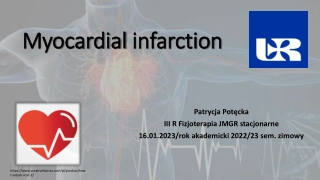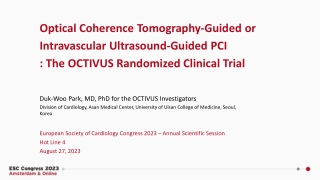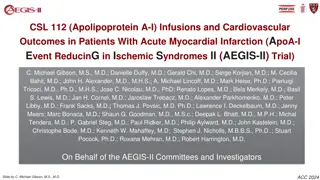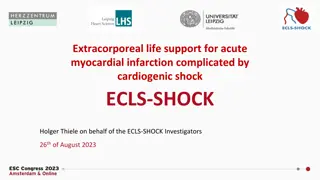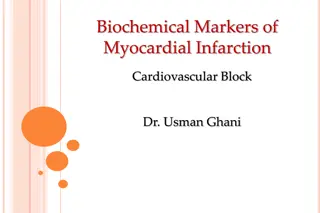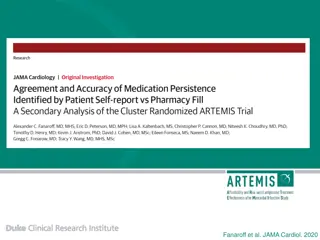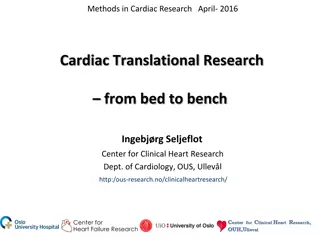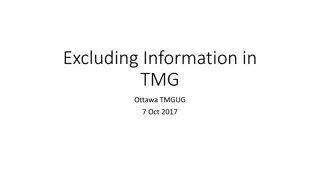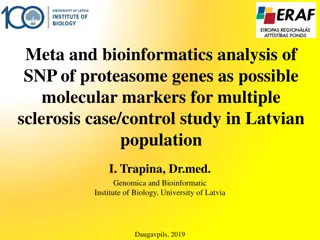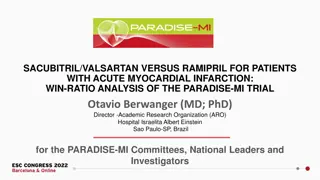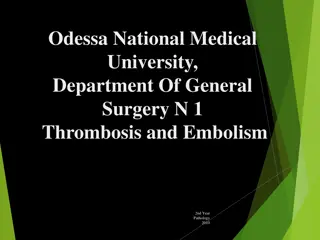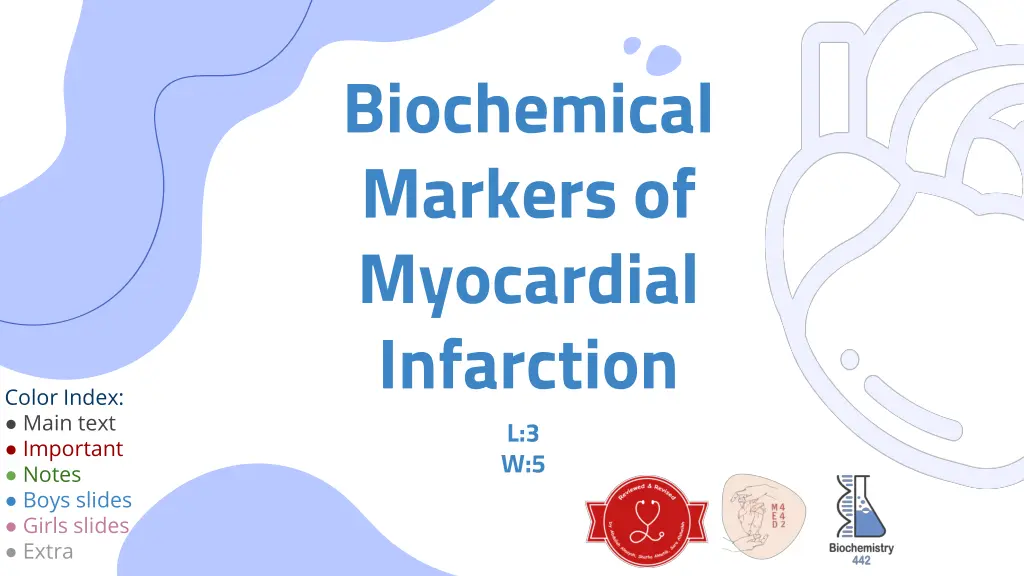
Biochemical Markers of Myocardial Infarction: Understanding Diagnosis and Cardiac Markers
Explore the criteria for diagnosing myocardial infarction (MI) and the significance of cardiac markers like troponins, CK-MB, h-FABP, and BNP. Learn about ideal markers and changes in plasma levels over time.
Download Presentation

Please find below an Image/Link to download the presentation.
The content on the website is provided AS IS for your information and personal use only. It may not be sold, licensed, or shared on other websites without obtaining consent from the author. If you encounter any issues during the download, it is possible that the publisher has removed the file from their server.
You are allowed to download the files provided on this website for personal or commercial use, subject to the condition that they are used lawfully. All files are the property of their respective owners.
The content on the website is provided AS IS for your information and personal use only. It may not be sold, licensed, or shared on other websites without obtaining consent from the author.
E N D
Presentation Transcript
Biochemical Markers of Myocardial Infarction L:3 W:5 Color Index: Main text Important Notes Boys slides Girls slides Extra
objectives Describe the general sequence of events of myocardial infarction (MI) List the criteria for diagnosis of MI Discuss the features of an ideal MI marker Understand the significance of changes in plasma marker levels over time Identify the properties and diagnostic value of cardiac troponins, creatine kinase, h-FABP and BNP Know about markers with potential clinical use
Myocardial Infarction (MI) Occlusion of coronary arteries Restricted blood supply (O2) to heart tissue (ischemia) Damage to heart tissue (infraction) Release of enzymes and other proteins into the blood (markers) Criteria for Diagnosis of (MI) Recommended by the European Society of Cardiology and American College of Cardiology Requires the presence of at least 2 of the following characteristics: * with contenues measurements of the Criteria for diagnosis of MI troponin every 4hr, first it will be reduced, then it rise quickly, then fall gradually. Characteristic rise and fall pattern of a cardiac marker in plasma Typical heart attack symptoms Typical ECG pattern Rise and gradual fall of cardiac troponins More rapid rise and fall of CK-MB E.g Chest pain radiate to the left shoulder Nausea,Sweating,Shortness of breath E.g. elevated ST segment.
Features of an Ideal Cardiac Marker The biomarker
Plasma Cardiac Markers Cardiac markers = Cardiac enzymes Markers with potential clinical use Markers no longer used Low specificity Current MI markers Aspartate Transaminase (AST) Lactate dehydrogenase (LDH) Ischemia modified albumin (IMA) Myoglobin Cardiac troponin T (cTnT) Cardiac troponin I (cTnI) Creatine kinase-MB (CK-MB) Myocardium Bound Heart fatty acid binding protein (h-FABP) *detecting heart tissue ischemia Markers of Diagnostic Value In myocardial infarction In Tissue Ischemia In Heart Failure Cardiac troponins T and I Creatine kinase (CK-MB) Heart fatty acid binding protein (h- FABP) Useful in early stage diagnosis B-type natriuretic peptide (BNP) Useful in late stage diagnosis
Time-Course of Plasma Enzyme Changes Time-course of plasma biochemical marker elevation after changes after MI Enzyme Abnormal activity detectable (Hours) Peak value of abnormality Duration of abnormality (Days) Troponin T or I 4-6 12-24 3-10 CK-MB isoenzyme 3-10 12-24 1.5-3 Total CK 5-12 18-30 2-5 Plasma enzymes follow a pattern of activities after MI Blood samples collected after MI: Baseline (upon admission) Between 12 and 24 hours after the onset of symptoms The initial lag phase lasts for about 3 hours Lag phase: a phase in which the conc. of plasma enzymes has not changed yet. No elevation in markers appears Enzymes rise rapidly to peak levels in 18-36 hours The levels return to normal based on enzyme half-life Rapid rise and fall indicates diagnostic value *CK-MB: Rapid rise and fall. Troponin: Rapid rise and gradual fall.
Troponins the most important biomarker -Troponins are structural proteins in cardiac myocytes and in skeletal muscle -Cardiac troponins (cTn) are structurally different from muscle troponins . -Involved in the interaction between actin and myosin for muscle contraction. -Highly specific markers for detecting MI. Enzyme Detectable in plasma Level peaks in Remain elevated Troponin 4-6 after MI 12-24 h Up to 10 days - After MI cytosolic troponins are released rapidly into the blood (first few hours). - Structurally bound troponins are released later for several days Two main cardiac troponin(cTn) Location of cardiac troponins cTnI cTnT Binds to Tropomyosin Mainly bound to proteins Small amounts soluble in the cytosol (Inhibitory protein) Troponin C is present in both cardiac and skeletal muscle cells, while cTnI and cTnT are expressed as cardiac muscle-specific isoforms
Creatine Kinase (CK) Three main CK isoenzymes with two polypeptide chains Bor M Type Composition Comment Skeletal muscle 98% CK-MM 2% CK-MB Elevated in muscle disease Cardiac muscle 70-80% CK-MM 20-30% CK-MB Cardiac muscle has highest amount of CK-MB Brain CK-BB Plasma Mainly CK-MM
CK-MB Relative index -CK-MBis more sensitive and specific for MI than total CK. -It rises and falls transiently (Last only for a short time) after MI. CK-MB mass / Total CK x 100 More than 5 % is indicative for MI Enzyme CK-MB CK-MB Detectable in plasma 3-10 h After MI Advantages Disadvantages Peaks in blood in 12-24 h 1- Useful for early diagnosis of MI. 1- Not significant if measured after 2 days of MI Returns to normal in 1.5-3 days 2- Useful for diagnosis of re- infarction. 2-Not highly specific (elevated in skeletal muscle damage)
B-Type Natriuretic Peptide (BNP) (Heart Failure Marker) Heart Fatty Acid Binding Protein (h-FABP) (Heart Tissue Ischemia Marker) A cytosolic protein involved in fatty acid transport and metabolism. It s a promising marker to be used in combination with troponins. Definition A peptide produced by the ventricles of the heart in response to myocardial stretching & ventricular dysfunction after MI. Definition Higher amounts in myocardium than in brain, kidney & skeletal muscle. It causes 1. Vasodilation 2. Sodium and water excretion 3. Reducesblood pressure Existing Appears in plasma as early as 30 min. after acute ischemia. Peaks in blood in 6-8 h. Returns to normal levels in 24-30 h. Appearance Detecting congestive heart failure. Differential diagnosis of pulmonary diseases and congestive heart failure (Important marker) Marker for Its serum levels are high in some pulmonary diseases but in heart failure its levels are markedly high. Facts
Pathogenesis of MI -With special focus on the biomarkers implicated in the development of MI. 1 2 Atherosclerotic plaque Plaque rupture 4 3 Tissue ischemia Thrombosis H-FABP 5 6 Tissue necrosis Myocardial dysfunction cTn CK-MB BNB 7 Heart failure BNB
Cases A 66-year-old man had experienced central chest pain on exertion for some months, but in the afternoon of the day prior to admission he had a particularly severe episode of the pain, which came on without any exertion and lasted for about an hour. On admission there were no abnormalities on examination and the ECG was normal. The troponin was clearly detectable. A well-trained marathon runner collapsed as he was approaching the finishing line. An ECG was normal but CK was elevated at 9500 U/L (reference range 30-200 UL), and the CK-MB was 14 % of the total CK (normally <6%). Troponin was undetectable. Comments: The total CK is substantially elevated and CK -MB > 6 % can usually be taken to mean that it is of myocardial origin. However, the normal ECG and troponin are both reassuring. in trained endurance athletes, the proportion of CK-MB in muscle increases from the normal low levels and may be as high as 10-15 % . An elevated CK- MB in such individuals can no longer be taken to imply a cardiac origin for the raised CK. Extreme exercise, especially in unfit individuals, causes an elevated CK, potentially to very high levels. Comments: Typical heart attack symptoms Characteristic Pattern of Cardiac biomarker He has an elevated troponin & a typical history. This is sufficient to diagnose a myocardial infarction by the most recent definition, even in the absence of ECG changes.
Take Home Messages cTn Currently the most definitive markers and are replacing CK-MB Highly specific to heart muscle damage They remain elevated in plasma longer than CK-MB They have higher sensitivity and specificity than CK-MB CK-MB Its main advantage is for detecting re-infarction h-FABP An early marker for detecting acute ischemia prior to necrosis BNP A cardiac marker that can be used for differential diagnosis of pulmonary diseases and heart failure
SUMMARY CLICK HERE SHOUT OUT TO TEAM441
MCQs Q1: What is the marker of diagnostic value in heart failure ? C :B-type natriuretic peptide (BNP) A:Cardiac troponins T and I B:Creatine kinase (CK- MB) D:Heart fatty acid binding protein (h-FABP) Q2:Which isn t an ideal feature of a cardiac marker? A:High sensitivity B:slow release C:High concentration D:rapid release Q3: After how many hours would the troponin be detectable? A:12-24 B:4-6 C:6-10 D:12-36
MCQs Q4: Our brain is mainly composed of: A: CK-MB B: CK-MM C: CK-BB D: CK-BM Q5: In heart failure BNP causes? A: Vasodilation B:NA & water excretion C: Reduces BP D: All of the above Q6:An important marker for differential diagnosis of pulmonary diseases and congestive heart failure? A: h-FABP B: BNP C: CK-MB D: CK-MM
SAQs Q1:list the 3 characteristics for the diagnosis of MI . Q2:list 3 current MI markers. Q3: Mention the advantages and disadvantages of CK-MB Q1 :slide #3 Q2 Cardiac troponin T (cTnT) Cardiac troponin I (cTnI) Creatine kinase-MB(CK-MB) Q3: Slide #9
Our Team Leaders Team members Raseel Alwehibi Sara Alotaebe Mashael Alsuliman Mohammed Ibn Saqyan Hoor Aloraini Nouf Aldhalaan Fatima Halawo Biochemksumed442@gmail.com

